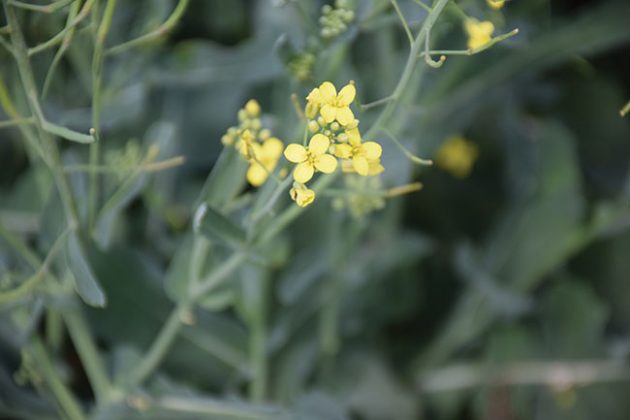
Features
Agronomy
Environment
Managing heat stress and frost avoidance in plants
Examining the importance of the plant cuticular layer in enabling tender annual crops to avoid environmental stress.
August 29, 2022 By Donna Fleury
 Dr. Karen Tanino, plant abiotic stress physiologist in the department of plant sciences at the University of
Saskatchewan, in the research greenhouse.
Photo Courtesy of David Stobbe, University of Saskatchewan.
Dr. Karen Tanino, plant abiotic stress physiologist in the department of plant sciences at the University of
Saskatchewan, in the research greenhouse.
Photo Courtesy of David Stobbe, University of Saskatchewan.
Environmental stress factors can be a challenge for annual field crop production on the prairies. Multiple factors such as heat stress, drought and frost, along with diseases and insect pests can significantly impact crop production and yields. Researchers are interested in developing potential solutions that can help crops avoid multiple environmental stresses.
“In my research program, we are always looking for common structures or mechanisms that may enable the plant to avoid multiple stresses,” explains Karen Tanino, plant abiotic stress physiologist in the department of plant sciences at the University of Saskatchewan. “Crop growers never know what the prevalent stress will be from one year to the next. For example, 2021 was very hot and dry in many areas, while the spring season in 2022 started with reasonable moisture but very cold nights. Our focus is on identifying common mechanisms and barriers that enable multiple stress resistance through an avoidance strategy, which is the ability of the plant to block or escape the stress. This is different from a more tolerance strategy in which plants are surviving in the presence of stress.”
Tanino says a significant finding of a recent study was how important the cuticular layer of the plant is for avoiding frost and dehydration stress.
“The development of the cuticle was a key innovation of avoidance in the evolutionary history of plants, which was essential in their colonization in the land from the water. As plants became more adapted, they built on those mechanisms that added avoidance. The cuticle covers the entire aerial portion of plants and actively works as a first line of physical barrier against all external environmental factors,” she explains.
“Under high temperature conditions, heat can build up in plants just like in a greenhouse, but some plants develop certain cuticular components that reflect light and UV to reduce moisture losses and dehydration. Similarly, frost damage occurs when ice that develops on the outside epi-cuticular layer of the leaf penetrates the plant, causing immediate and lethal injury to tender annual crops,” Tanino adds. “There have been many studies demonstrating the importance of the cuticular layer enabling plants to avoid drought or heat stress, however, few studies have examined multiple stresses including frost.”
In a new project funded by the Saskatchewan Ministry of Agriculture’s Agriculture Development Fund, Tanino is advancing this research to take a closer look at the role of specific genetic and biochemical components within the cuticle of canola and potato crops, and how they can help mitigate heat, drought, frost and other stresses. In particular, the new project will examine the cuticular layer to determine if adding another temporary protective layer could help avoid sudden frosts in potato; and to determine if specific wax components within the cuticle can be genetically selected for (and protect against) both heat and frost stress in potato and canola. The various objectives of this proposal have potential to support several sectors in addition to the canola and potato industries.
“The cuticle layer of plants is typically hydrophobic, but there are different degrees of hydrophobicity,” Tanino says. “The composition of the cuticle, such as certain wax components, affect the hydrophobicity or ability for the plant to develop a barrier to avoid water loss out of the plant or to avoid frost from forming and entering the plant. There is increasing interest in hydrophobic sprays and superhydrophobic materials for frost avoidance, but no commercial products have been tested for tender annual plants in Canada. There are hydrophobic polymers currently registered for other uses on the market in Canada – such as for insect pests in potato and vegetable crops, and for the prevention of sunburn on apples – however, they have not yet been tested for frost avoidance.”
One of the main objectives of this project will be to determine if hydrophobic sprays can cost-effectively enable heat and frost avoidance in tender annual crops. Several potential commercially scalable hydrophobic sprays/concentrations and experimental sprays will be evaluated for efficacy and phytotoxicity in potato and canola for frost avoidance in small plots and commercial fields. The project will begin testing these sprays for frost avoidance in the Phytotron at the university in fall 2022, applying heat and freezing stress treatments in the growth chambers set to 45 C and 10 C. Infrared thermography will be used to monitor the canopy temperature and freezing point depression of each treatment. Whole plants in pots will be sprayed and tested at both the seedling and mature stage with repeated measures at zero, seven and 14 days after spray treatment.
“In year two of the project [once the Phytotron lab work is completed], we will be collaborating with potato and canola growers to test the treatments in commercial fields under spring frost and mid-summer peak heat conditions,” Tanino says. “The two most effective hydrophobic sprays and their concentrations will be selected and validated under field conditions in potato and canola in the spring (frost on seedlings), mid-summer (heat stress during canola flowering) and in the fall (frost on mature plants). An infrared video camera will be used for monitoring heat and frost events in the field. The hydrophobic compounds will be developed as a foliar application that can be field-sprayed using existing farm equipment. The field trials will also be used to help optimize the treatments and applications for multiple stresses.”

Tanino’s new project aims to explore if the cuticular layer could protect against heat and frost stress in canola and potato crops.
Expanding the research
A second component of the project is focused on advancing Tanino’s previous research conducted by her research officer, Tawidur Rahman, that provided a clear and direct link between specific genes such as CER3 and DEWAX involved in cuticular wax biosynthesis, and increased frost avoidance/dehydration stress resistance in Arabidopsis. From the study, the key pathways in the model plant Arabidopsis were identified and linked to genes resulting in increased epicuticular wax, predominantly consisting of longer chain alkanes, and increased hydrophobicity, reducing water loss and frost injury. This molecular strategy will be investigated in canola in this new study.
A comprehensive gene expression analysis will be undertaken to identify the possible gene orthologs for CER3 and DEWAX in Brassica napus. Coding sequences of those orthologs will be utilized to generate over expressing lines to further identify the functional role of those genes in the biosynthesis of cuticular wax in B. napus. Over-expressing lines in seedlings and mature plants will be exposed to heat and freezing treatment assay to determine if CER1 and CER3 orthologs in B. napus can increase the heat and frost stress avoidance ability by accumulation of certain waxes in the cuticle. Candidate orthologs will also be tested by transient expression in Nicotiana benthamiana, a plant in the same Solanaceae family as potato.
“We will be using a rapid virus induced gene silencing (VIGS) system, developed by Kevin Rozwadowski’s lab at Agriculture and Agri-Food Canada, to transiently knockdown or decrease the expression of any target gene in B. napus,” Tanino explains. “This provides a quick and cost-effective means to assess gene function, especially in the case of multiple candidate genes controlling a phenotype. In this study, we will use the VIGS system to develop transiently expressed knockdown plants for CER1 and CER3 gene targets. VIGS enables us to develop a quicker less-expensive proof of concept to initially identify which gene or subset should be pursued for future molecular work via CRISPR, a more long-term expensive process.”
The team is collaborating with Mark Smith at AAFC Saskatoon, Jazeem Wahab at the Canada-Saskatchewan Irrigation Diversification Centre and Leon Kochian at the Global Institute for Food
Security, with industry in-kind support from SaskCanola and the Saskatchewan Potato Growers Association.
“By the end of the project, we plan to be able to provide practical solutions for growers that can help crops avoid frost, heat and other multiple environmental stresses,” Tanino says. “Many growers are planting crops earlier in the spring to improve productivity and yields, however, the risk of both spring and fall frost will only increase and not decrease with time as climates become more unpredictable and extreme. Tools to help growers address these production risks are increasingly important. We also will be developing tools for breeders that can help improve the ability of crops to avoid multiple environment stresses and stabilize yield and increase productivity.”